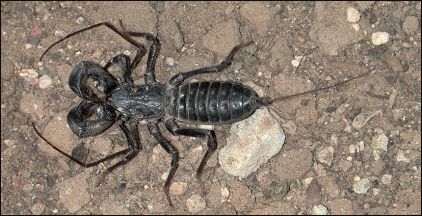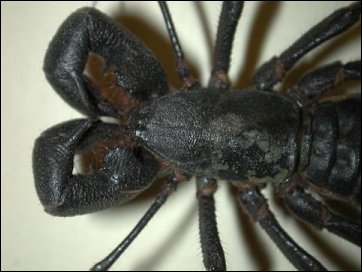
What smells like vinegar and has an evil reputation? Why the Chihuahuan Desert's vinegaroon. This arachnid, a group that includes scorpions and spiders, certainly looks horrendous. Formidable pincers, body size up to 3 inches, and dark coloration all elicit caution. People, then, may be forgiven for mistaking this basically harmless creature for a deadly desert denizen.
Give you a pinch? Quite possible, but hardly something to panic about. Despite the mythology, it's not poisonous, but does have one defense that's unusual. Disturbed, it will spray a mist from glands at the base of the tail. And what is this mist? In the common Trans-Pecos Texas species, it's made up of about 85% acetic acid—vinegar, in laymen's terms.
The smell then accounts for one common name; another common name is
whip scorpion, because of the long, whip-like (but harmless) tail appendage. This tail
appears to be a sensory organ, complementing the two front legs that are specially
adapted for detecting vibrations—the major way this nocturnal animal finds its
prey. Ugly—sure, but with lots of character. 
Contributor: Arthur H. Harris, Laboratory for Environmental Biology, Centennial Museum, University of Texas at El Paso.
Desert Diary is a joint production of the Centennial Museum and KTEP National Public Radio at the University of Texas at El Paso.

Vinegaroon. A live specimen from southeast of Findlay, Hudspeth County, Texas. Photograph by A. H. Harris.

Close-up of anterior portion of a vinegaroon. Preserved specimen. Photograph by A. H. Harris.
Texas Agricultural Extension Service